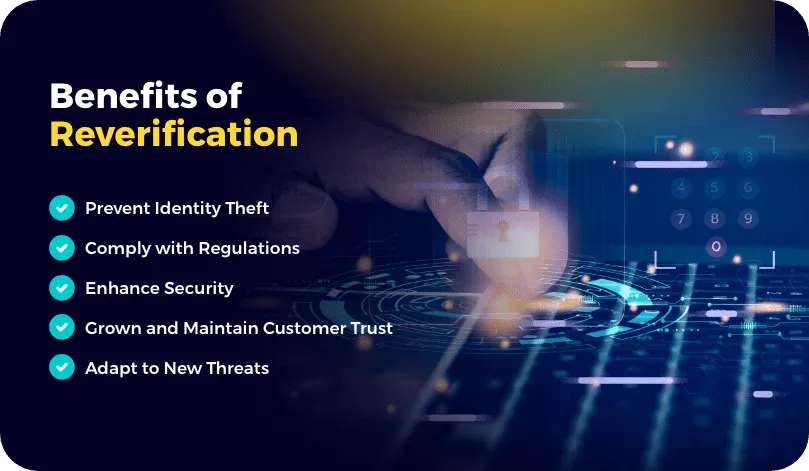Re-verification has become increasingly significant because the world is moving more identity-dependent transactions online. As a key aspect of Know Your Customer (KYC) and Know Your Business (KYB) practices, it is a regulatory formality and a crucial step in maintaining ongoing trust and security in business relationships.
While essential today, re-verification presents businesses with several challenges. This guide explores what re-verification is and reasons why it is a necessary step towards creating a more secure ecosystem for your business and customers.
You’ll also learn about the value of using a regular verification solution, understand the most common challenges businesses face on the path to offering re-verification, and explore four types of re-verification with examples.

The Meaning of Re-verification
Re-verification is the process of periodically updating and validating credentials of existing clients. This process ensures that client information a business holds is current and accurate. It is a required practice of KYC programs and vital in understanding the evolving nature of clients’ identities and business profiles.
Re-verification is also crucial in combating online identity fraud for several reasons:
Prevent Identity Theft: Regularly checking user identity authenticity helps detect and prevent identity theft. It ensures that the genuine individual controls the account, not someone who has fraudulently acquired their credentials.
Compliance with Regulations: Many industries have regulatory requirements for ongoing identity verification. Re-verification helps businesses remain compliant with these regulations and avoid penalties.
Enhance Security: Re-verification adds an additional layer of security. It’s a proactive measure that can identify and mitigate potential fraud before it occurs.
Grown and Maintain Customer Trust: Regular verification helps maintain trust between businesses and customers. It is a way of reassuring users that their identities and data are being actively protected.
Adapt to New Threats: Online fraud is advancing at an alarming rate. Re-verification allows businesses to stay ahead of new tactics employed by fraudsters by regularly updating and strengthening their verification processes.
Book a Demo
Give your business the boost of a fully automated, KYC process. No geographical limits and fast, frictionless onboarding verification processes enhance customer’s experience.
Challenges of Re-verifying Customers
The process of re-verifying client information can be complex and resource-intensive. It includes managing large volumes of data, ensuring compliance with evolving regulatory standards, and balancing thoroughness with efficiency. Businesses must also navigate the delicate task of requesting sensitive client information without straining customer relationships. Here are key obstacles businesses must overcome:
Bottlenecks and a Lack of Resources: Most businesses use dated verification processes, often relying on manual checks. While a solution to the need to verify customers initially, manual checks can cripple efficiency. More workforce is required to verify customers, and each verification experience can be painful for customers who want to complete transactions quickly. Manual verification is also human-centric and, therefore, prone to error. Over time, an increase in error exposes organizations to greater liability.
Data Breaches and Sophisticated Fraud: The world has seen more data breaches as more sensitive information has moved online. Criminal organizations have become more sophisticated, targeting high-value marks to access sensitive monetary information. This data often includes personally identifiable information like email addresses, bank account details, passwords, and credit card numbers.
Businesses storing sensitive personal data have the burden and responsibility of protecting it, a requirement few are meeting successfully.
Synthetic Identity Fraud: The rise of synthetic identity fraud is a major contributing factor. Fraud has received a boost in the form of artificial intelligence tools like generative AI, AI capable of producing high-quality, life-like fakes. Fakes make it challenging to ensure the security and integrity of the re-verification process because this type of fraud is notoriously difficult to detect and is growing rapidly.
Balancing Security and User Experience: Ensuring a stringent re-verification process while maintaining a smooth and non-intrusive user experience can be complex. Friction in the verification process creates discomfort that can hurt brand loyalty and brand equity.
Organizations must balance maintaining robust security for safeguarding against identity fraud and unauthorized access while creating seamless verification experiences.
Stringent Compliance Requirements: Compliance and regulatory laws are evolving much faster to address new fraud tactics driven by technologies like generative AI and orchestrated large-scale attacks by criminal organizations. This quickening places businesses under pressure to achieve compliance or face heavy fines.
How can re-verification help your business?
Effective re-verification strategies can improve any business’s posture, enhancing security that fights fraud while improving workflows and operational efficiency. Notable wins include:
Fraud Prevention: Well-oiled re-verification processes improve an organization’s ability to detect and prevent identity fraud and financial crimes. Introducing a can help thwart fraud before it has a chance to take place, limiting risk for the organization and its clients.
Compliance and Legal Protection: Introducing smart and automated re-verification ensures adherence to regulatory requirements, helping organizations avoid legal penalties.
Maintaining Business Reputation: Introducing re-verification signals a firm commitment on behalf of the organization to its customers. It shows a genuine interest in protecting customer interests, and the upside can be lucrative. Supporting customer education on the purpose and value of re-verification can help customers develop a stronger sense of trustworthiness towards a brand.
Operational Efficiency: Streamlining client data management processes adds a level of operating efficiency previously unattainable. With more accessible and reliable ways to verify customers regularly, businesses shift from manual processes prone to error to automated and highly accurate systems that save time and resources.
Types of Re-verification
There are several ways to perform re-verification. Each offers some benefits, while others, like automated re-verification, deliver the most value. Here’s a look at each, along with examples of how they can be used:
Documentary Re-Verification involves validating client identity and business documents. Examples include:
- Identity Verification: The client is asked to provide official identity documents, such as a passport or driver’s license. The bank then checks these documents to confirm they are valid and match the identity of the client on record.
- Business Document Validation: The bank might also require business-related documents if the client is applying for a business loan. These could include business registration certificates, financial statements, or tax returns. The bank verifies these documents to ensure the business is legitimate and financially stable.
- Cross-Verification with Databases: A bank may cross-reference the information provided with external databases or credit bureaus to validate the client’s identity and creditworthiness.
Non-Documentary Re-Verification uses alternative methods such as third-party data sources. Examples include:
- Database Verification: The bank checks the client’s identity information against authoritative sources, such as government databases or credit bureaus. This could involve validating the client’s name, address, date of birth, and Social Security number.
- Digital ID Verification: The bank may use digital platforms that aggregate data from various sources to verify the client’s identity. This might include checking the client’s digital footprint and transaction history.
- Biometric Verification: Some banks employ biometric verification system like facial recognition or fingerprint scanning, where the client’s biometric data is matched with data held in secure databases.
Automated Re-Verification leverages technology solutions for continuous monitoring and validation. Examples include:
- Advanced Technology and Software Solutions: Financial institutions use software that automates verification processes, continuously checking client information against various data sources without manual intervention.
- Ongoing Customer Activity Monitoring: The system actively monitors customer activities, flagging any unusual transactions or changes in behavior patterns that might indicate identity theft or fraud.
- Data Validation Testing: Automated systems ensure data integrity and quality throughout the verification process, validating the data as it moves from its source to its target, ensuring that the information remains accurate and up-to-date.
- Security Control Assessments: These automated systems also continuously evaluate security solutions, employing non-destructive attack simulations to ensure the robustness of security controls in place.
Manual Re-Verification involves personal interaction and manual checks. Examples include:
- Personal Interaction: When a patron enters a casino and needs to be verified, particularly for large transactions or high-stake games, the verification process may involve personal interaction with casino staff.
- Manual Document Checks: Casino administrators or security personnel manually check a patron’s identity documents, such as a driver’s license or passport, to . This process is carried out by physically examining the documents for authenticity and comparing the photo ID with the patron’s appearance.
- In-Person Verification: Additional verification steps, like asking security questions or confirming personal details verbally, might be conducted to ensure that the document holder is indeed the person they claim to be.
Note: Manual re-verification is subject to human expertise. Since this process relies on the expertise and judgment of the verification personnel, it requires substantial training in document examination and fraud detection. This form of verification often includes tools capable of spotting fake identification and documents .
Summary
Re-verification is critical for maintaining secure, compliant, and trusted business relationships. Implementing effective re-verification practices ensures regulatory compliance and bolsters a company’s integrity and resilience against fraud. As financial transactions and business interactions evolve, re-verification remains an indispensable tool in a business’s arsenal to safeguard its operations, customers, and reputation.







